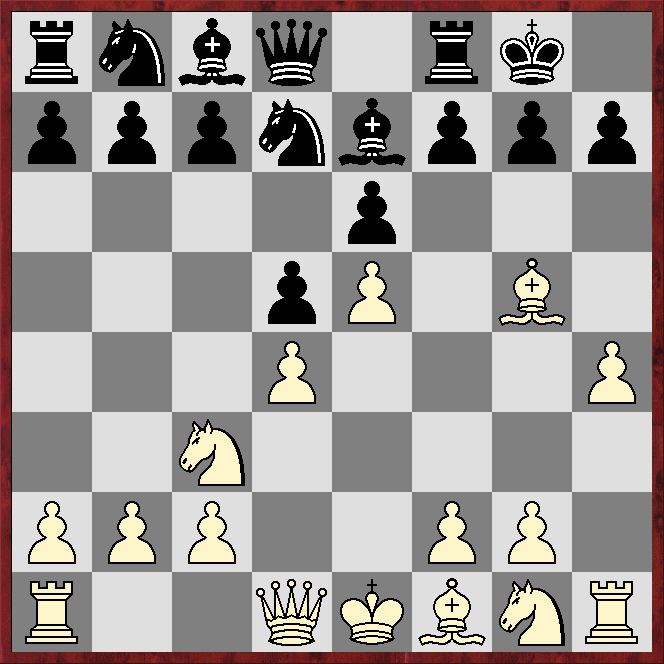The full game can be seen at S1 but here I will concentrate on the sharp opening.
Play began 1.e4 e6 2.d4 d5 3.Nc3 Nf6 4.Bg5.
My opponent continued with 4...Be7, the most popular move in ChessBase's 2022 Mega database.
At club level a commonly played alternative is 4...Bb4, the McCutcheon Variation, while at elite levels it is probably correct to say the main continuation these days is 4...dxe4, the Burn Variation.
Part of the popularity of the Burn with grandmasters is, I suspect, due to its recommendation by French Defence expert John Watson in the third edition of Play The French (Everyman Chess, 2003).
After 5.e5 Nfd7 (5...Ne4!? and 5...Ng8?! are also tried by strong players) the natural continuation is 6.Bxe7, but Garry Kasparov is among those who have preferred 6.h4!?
This gambit is credited to Adolf Albin, who played it at a Vienna tournament in 1890, but is usually known as the Alekhine-Chatard Attack.
Although Albin's 1890 opponent, Adolf Csank, took the offered pawn and obtained a draw, the gambit is usually declined.
Stockfish15 reckons the best way of declining is 6...h6, eg 7.Bxe7 Qxe7 8.f4 a6, albeit conceding White has at least a slight edge (Komodo13.02 reckons the position is equal).
The latter engine prefers to decline with the move my opponent chose, 6...0-0!?
*****
*****
*****
*****
The most popular line in Mega22 runs 7.Bd3 c5 8.Qh5 g6 9.Qh6, when Stockfish15 reckons White has a positionally won game but Komodo13.02 calls the position dead-equal.
I preferred the arguably more-direct 7.Qg4!?
I preferred the arguably more-direct 7.Qg4!?
*****
*****
*****
*****
7...Kh8
This is Komodo13.02's choice but most popular in Mega22 is 7...f5, although the engines reckon 8.Bxe7 Qxe7 9.Qg5 gives White at least a slight edge.
Stockfish15 likes 7...f6!? despite the reply 8.Qxe6+. After the further moves 8...Kh8 9.exf6 Nxf6 Stockfish15 reckons Black's lead in development gives good compensation for a pawn.
I developed with 8.Nf3, and the engines agree with the game continuation of 8...c5, which attacks the white centre (8...f5?! also occurs in Mega22 but the engines strongly dislike it, reckoning any reasonable reply - 9.Qh5, 9.Qf4, 9.Qg3, 9.Bxe7 - gives White an advantage).
*****
*****
*****
*****
9.Bd3!
This is possible, and good, since 9...c4? loses to a simple combination, ie 10.Bxh7 Kxh7 11.Bxe7 Qxe7 12.Qh5+ with mate to follow.
An interesting alternative is 9.Nb5, which is preferred by Stockfish15 for a short while. After 9...Nc6 the engine reckons 10.Bd3 gives White the upper hand, but Komodo13.02 calls the position dead-equal.
9...f5
The engines agree this is Black's best chance, and it has the practical advantage that the reply 10.exf6, which White normally wants to play in such positions, allows at least equality, according to the engines, after 10....Nxf6. Nevertheless 10.exf6 was played in three of the six games in Mega22 to reach the position.
I preferred 10.Qf4, which was met by 10...Nc6, continuing Black's pressure against the white centre.
Herman van Riemsdijk (2420) - Alfeu Bueno (2200), Festa da Uva Rapid (Caxias do Sul, Brazil) 2010, continued 11.g4? cxd4 12.Nxd4 Ndxe5 13.Nxc6 Nxd3+ 14.cxd3 bxc6 (0-1, 40 moves), but 11.0-0-0 was an easy-to-find improvement.
Herman van Riemsdijk (2420) - Alfeu Bueno (2200), Festa da Uva Rapid (Caxias do Sul, Brazil) 2010, continued 11.g4? cxd4 12.Nxd4 Ndxe5 13.Nxc6 Nxd3+ 14.cxd3 bxc6 (0-1, 40 moves), but 11.0-0-0 was an easy-to-find improvement.
 |
| The opening can be thought to have ended and the middlegame begun as one side has connected rooks - how would you assess the position? |
*****
*****
*****
*****
White has a substantial lead in development and more space in the centre, but the position is closed and Black has obvious counterplay on the queenside. The inclusion of opposite-side castling adds to the difficulty of being sure of any evaluation, but Stockfish15 gives White the upper hand, while Komodo13.02 reckons White has a slight edge.
CONCLUSION: the Alekhine-Chatard Attack is a sharp system in which Black is under early pressure. The conflicting assessments of the engines are various points is testament to how complicated play can be.



No comments:
Post a Comment